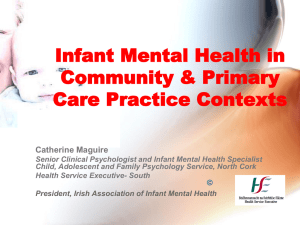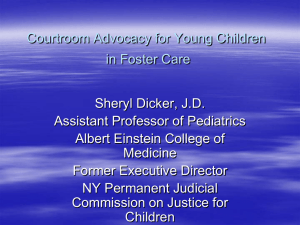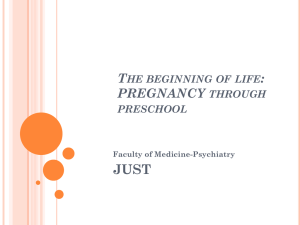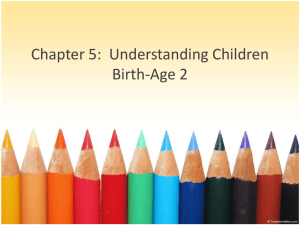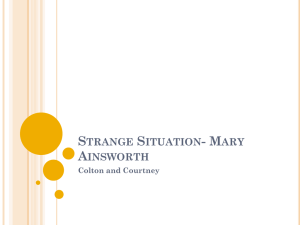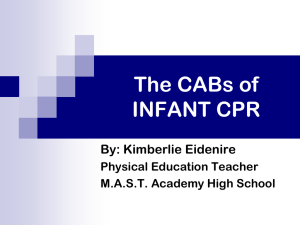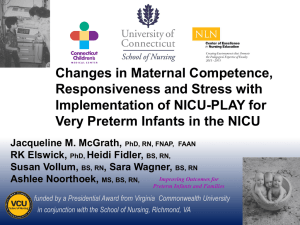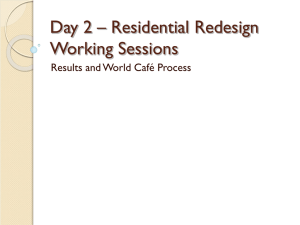Together Now
advertisement
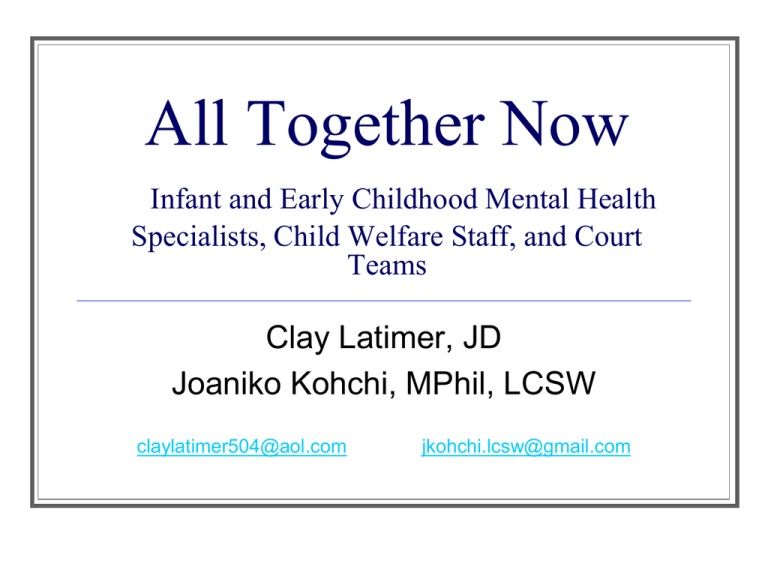
All Together Now Infant and Early Childhood Mental Health Specialists, Child Welfare Staff, and Court Teams Clay Latimer, JD Joaniko Kohchi, MPhil, LCSW claylatimer504@aol.com jkohchi.lcsw@gmail.com Learning Objectives Articulate the importance of early attachment relationships for infants and young children, and the means by which relationships may be assessed and promoted. Demonstrate a familiarity with both court- and agency-based multi-disciplinary teams formed in support of promoting healthy parent-child relationships. Learn about the connection between infant mental health team objectives and compliance with federal mandates for permanency. National Center for Children in Poverty: SocialEmotional Development in Early Childhood Studies show that many young children with identified needs and their parents do not receive services Between 80 and 97 percent of children ages 3 to 5 with identified behavioral health needs did not receive services Even in structured early learning settings, such as Head Start, 80 percent of parents needing mental health services did not receive them WAIMH’s Definition of Infant Mental Health The ability to develop physically, cognitively, and socially in a manner which allows them to master the primary emotional tasks of early childhood without serious disruption caused by harmful life events. Because infants grow in a context of nurturing environments, infant mental health involves the psychological balance of the infant-family system. WAIMH Handbook of Infant Mental Health, vol 1, p. 25 Infant and Early Childhood Mental Health The quality of the attachment relationship bears directly on the emotional health of the infant and young child and is predictive of future health or pathology in ALL domains. Infant and Early Childhood Mental Health The assessment and intervention focus on the caregiver-child relationship/s. The caregiver is as much a part of the therapeutic process as the infant or child. Qualities of Relationship-Based Practice Values early developing relationships between parents and young children as the foundation for optimal growth and change; Directs all services to nurture early developing relationships within families; Values the working relationship between parents and professionals as the instrument for therapeutic change; From http://www.mi-aimh.org/ Relationship-Based Practice… Values all relationship experiences, past and present, as significant to one’s capacity to nurture and support others. From http://www.mi-aimh.org/ Some Relationship Assessment Tools (require special training/supervision) Working Model of the Child Interview (Zeanah & Benoit, 1995) Face-to-Face Still-Face Paradigm (Tronick) Modified Parent-Child Relationship Assessment (Crowell et al.) 9 Evidence-Based / Empirically-Based Interventions National Registry for Evidence-based Programs and Practices http://www.nrepp.samhsa.gov Search for ages 0-5 = 31 interventions ONE is based on the relationship between a caregiver and child: CHILD-PARENT PSYCHOTHERAPY TRAUMA-INFORMED CHILD-PARENT PSYCHOTHERAPY Infant Mental Health Specialists Are from a variety of disciplines Have a range of core competencies Practice in diverse settings, including multidisciplinary teams dedicated to high-risk populations Infant Mental Health in/around/for the Child Welfare System Refer out to community providers and programs Create a coordinated team of providers, including Part B and Part C programs, community mental health, substance abuse treatment programs, parenting classes and support, child care programs, etc. Infant Mental Health in/around/for the Child Welfare System Create a multi-disciplinary team funded by the Department, based in a specialized setting, such as a medical school Create court-based teams dedicated to coordinating experts and community providers Or partnering with an expert multi-disciplinary team Focus today on… teams supporting infants and young children in foster care, their families and caregivers. Infant Mental Health Teams in Court Federal laws and corresponding state laws that guide us in planning for children in foster care. Adoption and Safe Families Act Fostering Connections Act ADOPTION AND SAFE FAMILIES ACT/ASFA (1997) Focus on safety and permanence for children HIGHLIGHTS FOR 0 – 5 POPULATION A. Establishes new time line and conditions for filing of termination of parental rights - Must file if child has been in custody of department for 15 of the last 22 months. Exceptions: Compelling reasons – state is authorized to define the compelling reasons. Examples are child is being cared for by a relative or state has not provided services necessary to return child to a safe home. B. Modifies reasonable efforts requirement to relieve state of obligation to make reasonable efforts to reunite if a court finds that parent has subjected the child to certain aggravating circumstances (abandonment, torture, chronic abuse, sexual abuse, murdered another child of the parent, committed a felony resulting in serious bodily injury to the child or another child of the parent, or the parental rights of the parent to a sibling of the child have been terminated.) If the state is relieved of the reasonable efforts obligation, there must be a permanency hearing within 30 days of the court’s determination. ASFA (1997) C. Authorizes concurrent planning allowing states to make reasonable efforts to place a child for adoption (i.e., in dually certified foster home) while concurrently attempting to return child with his/her parents. D. Sets new/tighter time frame for permanency hearings: within 12 months instead of 18 months (Plans: Return to parents, Adoption, Refer for legal guardianship, or an alternative permanent living arrangement after documenting a compelling reason for determining that other options are not appropriate.) FOSTERING CONNECTIONS TO SUCCESS AND INCREASING ADOPTIONS ACT (2008) HIGHLIGHTS FOR 0 – 5 POPULATION Requires states to make diligent efforts within 30 days of child’s placement in foster care to identify and notify all of the child’s adult relatives of the child’s placement in foster care and (1) explain the relative’s options to care for the child, (2) explain procedures/requirements for foster care certification, and (3) inform relatives of availability of kinship care payments. (Note: Family/domestic violence exception) Requires states to make reasonable efforts to place siblings together or, if contrary to the safety or well-being, requires frequent visitation among siblings or other on-going interaction unless contrary to safety or well-being of the children. Fostering Connections (2008) Requires states to coordinate healthcare for children in foster care and to ensure appropriate screenings and assessments, like early childhood screenings, and to follow-up on services. Federal support to train people who are caring for and working with children in foster care including guardians, court personnel, attorneys, and CASAs. Achieving Permanency for Infants in Foster Care Infants have a better chance of achieving permanency in an alternative setting than older children do. Although there are different models of IMH teams, they share three core beliefs (Hudson, Klain, et al. via the Zero to Three Policy Center): Goals of IMH Teams Improve outcomes for abused or neglected infants Reduce the recurrence of abuse/neglect Change the Court’s culture to focus on needs of infants and toddlers Cindy Lederman, Science in the Courtroom, 2010. Three Core Beliefs: Valuing the importance of relationships among professionals, between professionals and families, and between the parents and their children. Interventions informed by science and experience lead to better outcomes. Communication and collaboration between professionals and families are necessary to create plans that meet children’s and families’ needs. Key Components Judge as leader and catalyst guiding the partnership between family service workers and the infant mental health team. DCS must have training and expertise in working with the multi-disciplinary team of IMH professionals. Attorneys must have training/expertise in working with IMH professionals. Interventions must be research-based. Key Components, continued Early intervention services must be in place (IDEA and CAPTA). Mental health services for parents and infants must be available from IMH professionals. Case monitoring and tracking occurs frequently. Appropriate resources are available (parenting programs, etc.). Funding supports the team. Models We Know Tulane Infant Team, New Orleans, LA LSU Court Team / Orleans Infant Team Infant-Parent Court Affiliated Intervention Project, Bronx, NY Achieving Permanency through IMH Teams Enhancing quality of expert testimony. Guiding parents to a clear and timely understanding of what will be entailed in providing appropriate care. Assisting parents in their own selfassessments. Results: Achieving Permanency Parents reunifying are more confident and better able to implement parenting lessons. Good evidence and testimony for successful outcomes when termination is indicated. Parents can accept and be comfortable with decisions about surrendering. Relative adoptions can occur more smoothly because parents participate in locating and recruiting with the help of an IMH clinician. Considerations for Best Practice Clear boundaries between the bench and the team of professionals supporting the child and family. Leadership vs. membership. Inclusive practice vs. healthy boundaries: does everyone come to every meeting? Relationship-specific assessment and intervention focusing on the needs of each child. Safety for children, parents and professionals.



